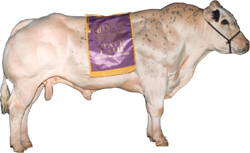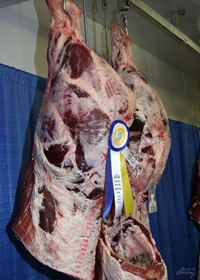The Belgian Blue Beef Breed
Purebreds
Belgian Blue Beef is famous for its impressive muscling which is commonly referred to as “double muscling.” Belgian Blue Beef outclasses all other beef breed in carcass yield (up to 80%). When used in crossbreeding programs of other dairy or beef breeds, it increases carcass yield from 5 to 7% compared to the maternal line.

The breed with “double muscle”
Extensive research has shown that Belgian Blues possess a gene which suppresses the production of myostatin, a protein that normally inhibits muscle growth after a certain point. Pure Belgian Blues carry two copies of this gene; in crossbreeding, one copy is usually transmitted and serves to increase carcass weight in the offspring of a cross-breeding program.
Belgian Blue Characteristics
Weights and Size: Belgian Blues are a moderately framed breed. Mature females weigh around 780 kg (1700 lbs) and are 138 cm (53 inches) tall. Adult bulls weigh 1200 kg (2700 lbs) and are 155 cm (61 inches) tall.
Adaptability: Belgian Blues have developed a quality and adaptability beyond comparison. The gene pool behind the breed has made the breed thrive on a wide range of terrains and in very different climates. Belgian Blues prosper in bitter Canadian winters and hot Texan and South American summers.
Colour Coat
- The breed comes in 3 main colours: white, blue, black
- Blue animals are blue or blue roan
- Black animals are totally black or black and white
- The red factor is present in some genotypes
Carcass Yield
- Up to 80% dressing out percentage for full bloods
- Carcass composition: 80% saleable boned-out meat!

Relationship between carcass and linear classification scores
The research and experience on the relationship between carcass yield and linear classification scores can be a great help in selecting bulls for high yielding carcasses. Even if the bull is not classified, it indicates the important factors to look for in selecting the ideal bull for terminal crossing. According to the criteria below, keen attention should be given to muscling when selecting a bull to optimize carcass yield.
How does linear classification scoring influence carcass yield?
- Extremely strong influence on carcass yield: Perfect roundness in thighs, rear view.
- Very strong influence: Wide exterior pelvis, very wide shoulders, rounded rib, very rounded thighs (side view).
- Strong influence: Chest (width between front legs), extreme muscling of the top line.
- Moderate influence: Sloping rump, long pelvis.
- Slight influence: Body length.
- Little or no influence: Height, bone structure, tail setting, skin thickness.
A bit of history: It is widely accepted Belgian Blues originated in the early 1900s when a few Durham Shorthorns were introduced into the local cattle population in Southern Belgium, although blue coated animals were often mentioned during the Middle Ages on the actual Belgian territory. Initially employed as a double purpose animal, breeders began selecting for the heavy muscling trait around 1950. The breed was well established by then and from 1960 onward scientific genetic selection techniques were used to further the expression of a high proportion of muscle. This eventually led to the now familiar double muscling trait which makes the Belgian Blue such an exceptional breed.
Crossbreeding with Belgian Blues…
“Primary results indicate that Belgian Blues are
excellent candidates as a terminal sire breed”
Cundiff and aI. USDA, Clay Center
The ULTIMATE Terminal Crossbreeding Breed
Using a Belgian Blue Bull in your commercial herd crossbreeding program will maximize your profits:
- Outstanding dressing percentages
- Very docile temperament
- Up to 10 % more lean retail product
- Early maturity
- Excellent feed conversion rate
- Tenderness thanks to fine muscle fibers
- High growth rates
- High protein content
- Easy calving
- Meat flavor and juiciness
- Always pick a white bull in crossbreeding on Holsteins if a typical Blue calf is desired.
Common Breeder Questions
Why is Belgian Blue meat more tender?
Meat is basically composed of muscle fibre with some fat in between and connective tissue. The more muscle fibre you genetically pack into a volume of meat, the less room there is for tough connective tissue and fat. Interestingly, research has proven that muscle growth is related to tenderness (Renand et al).
What is the best type of Belgian Blue bull in terminal crossbreeding?
There is no simple answer to this question. But because we know 50 per cent of the genetic influence comes from each parent, we know that breed and cow type will influence the final choice. We also know that when a full blood Belgian Blue bull is used with a cow from another breed a good deal of benefit results. Thanks to heterosis one can expect better performance than the average of the two parent breeds. Moreover, calves will be more vigorous. However, because of the recessive nature of the double muscle genes characterizing the Belgian Blue breed, you can only get good results with full bloods or high percentage bulls. The gene cannot be used to put a little bit of muscle in the bull. You either have it or you don’t. In fact, the recessive Belgian Blue gene already diluted in a low percentage bull will be even more diluted in its offspring. If you use a 50 per cent bull expect to see only 50 percent of calves to show muscling improvement over the dam’s type. Conversely, if a full blood is used, all calves will show noticeable improvement in muscling over the dam.
Terminal cross breeding with Belgians improves the dressing percentage (or kill-out per cent) but even more so the cutability (or net saleable meat yield), and VERY importantly, tenderness.
How much improvement can I expect?
Research shows that dams from the poorest meat type give the biggest improvement in carcass yield. For example, crossing a Belgian Blue with a dairy breed will improve the carcass more than crossing it with a beef breed. But the end result will be better with good beef type dams than with dairy. Dairy farms report dressing percentages of 60 / 63 per cent on Holstein steers sired by a Belgian Blue. These figures are in line with research done in England (Minter and Tempest), Belgium (Hanset et al) and Germany (Von H. Gerhardy). Research also shows that the crosses will dress out better than when other beef sires are used with Holstein dams. Even with Jersey, there have been very few calving problems, and dressing percentages have been around 57 per cent.
On beef breeds, Belgian Blues as terminal cross will always give positive results. Beef breeds are often selected based on different criteria: easy calving, good mothering qualities, resistant to a harsh environment. In every case Belgian sires have improved the dressing percentage, by 10 per cent using poorest type cows and between two to five per cent on meaty types.
Daily gain and carcass yield are qualities highly desired to be passed on the next generation. The hereditability of those factors is around 0.50.
To find the right bull for your needs...
New line of Internationally bred BBB Bulls now available in Canada
